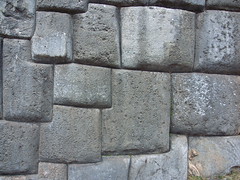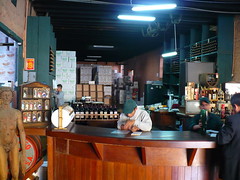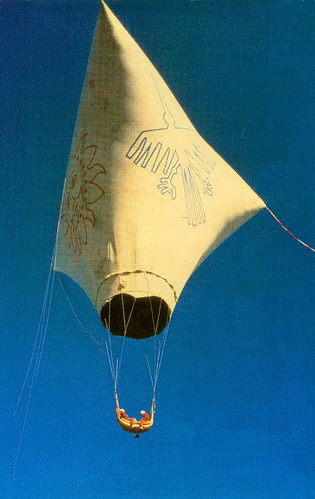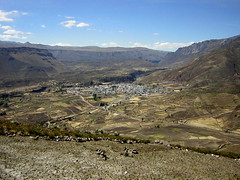Pedro Paulet and the Peruvian rocket-plane
Little is it known that the technology that led to the landing of man on the moon, of faster than sound jet planes and intercontinental missiles… first saw form in the experiments of a Peruvian in the late 1800s early 1900s… decades before it was successfully tried again by the man recorded in history as the inventor.
 Pedro Paulet, born in Arequipa in 1874, is said to have always been fascinated by rockets as a child, he himself accrediting that fact years later to Arequipans love of fireworks using during parties, something that made the average person oblivious to the dangers of handling high explosives.
Pedro Paulet, born in Arequipa in 1874, is said to have always been fascinated by rockets as a child, he himself accrediting that fact years later to Arequipans love of fireworks using during parties, something that made the average person oblivious to the dangers of handling high explosives.
Studying first at a local French school, then with merits as a teenager in a local university, he was awarded a scholarship by the Peruvian government in 1894 and sent to study engineering at the Sorbonne in Paris. In France, he attended lectures by a renowned chemist Marcelin Berthelot, later enrolling at the Applied Chemistry Institute at the University of Paris to study with the man himself. He explained years later: “at the Institute I was mainly attracted to the work of Berthelot, on the forces of explosive materials. I could not understand why his book is not featured in every technical library.”
He graduated in 1901, but since the first time Berthelot sparked his interest in the explosive forces unleashed by chemical reactions he had been quietly working away in his lab on a number of projects, continuing his childhood obsession with rockets and propulsion with the eventual aim improving manned flight which itself was a very new concept.
The first experimental rocket engine
 Dubbed the “Paulet Engine”, it was the world’s first, created in Paulet’s Paris lab in 1895 – just a year after the Peruvian arrived in France. Devised out of personal frustration that steam engines had become relics of the past too weak to power the futuristic visions of human air travel the Peruvian scientist had in mind and that the recent combustion engines were too new and heavy to be used to power anything that had to be light, he devised the rocket motor.
Dubbed the “Paulet Engine”, it was the world’s first, created in Paulet’s Paris lab in 1895 – just a year after the Peruvian arrived in France. Devised out of personal frustration that steam engines had become relics of the past too weak to power the futuristic visions of human air travel the Peruvian scientist had in mind and that the recent combustion engines were too new and heavy to be used to power anything that had to be light, he devised the rocket motor.
Paulet disliked current aircraft designs. To him they were too imperfect and too primitive, mostly because of the propulsion technology they employed. He stated that the perfect aeroplane should: “(1) Rise up vertically, (2) maintain itself at any point in the atmosphere, (3) fly at an altitude of no more than 20,000 metres, (4) possess an exterior not deformed by atmospheric pressure, (5) could descend vertically”. The only way he saw this would be possible was with rocket engines.
 Paulet’s design consisted of a conical shaped combustion chamber into which was pumped liquid fuel of nitrogen peroxide and gasoline. A spark-plug initiated the detonation and the resulting force was fed out of the wider end of the cone creating propulsion.
Paulet’s design consisted of a conical shaped combustion chamber into which was pumped liquid fuel of nitrogen peroxide and gasoline. A spark-plug initiated the detonation and the resulting force was fed out of the wider end of the cone creating propulsion.
The man himself explains:
The results of these experiments were very satisfying. A single two-and-a-half kilogram rocket, undergoing 300 explosions per minute, could not only maintain a constant pressure against the dynamometer, of up to 90 kilograms, but could operate without damage for nearly an hour. Under such conditions, it would not be reckless to predict that, using two batteries of 1,000 rockets apiece, one in operation while the other rested, it would have been possible to lift several tons.
Using various kinds of explosives, he concluded that liquid fuel was ideal for his motor which he intended to use for his own aircraft. His fully functioning aircraft motor was called the “Girándula”.
It consisted of a bicycle wheel, fitted with three rockets fed by tubes attached to the spokes. The fuel comes through the tubes from a kind of fixed carburetor, placed near the axis, with a ring of holes. This explosive mixture flows through the tubes, every time the nozzle faces one of the holes. The number of rockets could be increased, until they come to look like a comfortably enclosed turbine.
The work was dangerous and in the experimentation an accident occurred that saw Paulet slightly injured and with a perforated eardrum. As a result, the director of the Institute banned all work with explosives at the modest facilities and the police arrested Paulet on suspicion of him being an anarchist. Released after Berthelot testified to the true purpose of his work, authorities informed him that projects such as his could only be undertaken at military bases or in specialist labs.
Suspending his work for what he hoped would only be a short time, he served in diplomatic roles of behalf of the Peruvian government before returning to Peru in 1905 as a highly respected man – so much so he got caught up in more diplomacy and bureaucracy. He was asked to serve as the director of Escuela Nacional de Artes y Oficios, while also becoming involved in the construction industry – he had also studied architecture. He was asked again to serve in consular posts in various countries and so spent most of the rest of his life in Europe unable to continue his experimentation.
Peruvian Spaceships
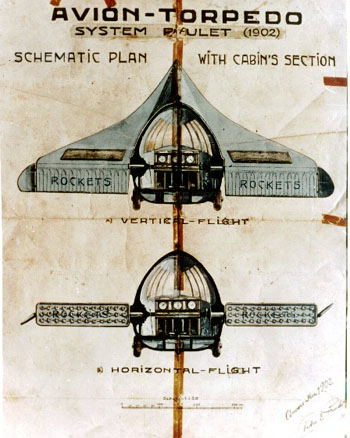
The Torpedo Plane
Not only was Paulet interested in flight, but according to those who knew him and he himself years later, he was interested in space travel – a subject of ridicule even in this most scientific of times: “what we must study is not aviation as it comes from the birds, and which only invites us to imitate flight, but weightlessness. Transport above the planet must be probed, where there is no air, no clouds, no ice”.
As amazing as it sounds, Paulet intended for the aeroplane that would be powered by dozens of his rocket engines to leave earth’s atmosphere and even be able to travel beneath the sea.
 In 1902, Paulet designed his aircraft, dubbing it the Torpedo Plane. He wanted rid of propellers and gliders and for them to be replaced with new “astrodynamic” functions now that gravity had been overcome by his engine.
In 1902, Paulet designed his aircraft, dubbing it the Torpedo Plane. He wanted rid of propellers and gliders and for them to be replaced with new “astrodynamic” functions now that gravity had been overcome by his engine.
It is important to note that while the Peruvian was designing vehicles to “traverse stellar space”, in the United States the Wright brothers were flying gliding planes. Paulet’s craft was to take passengers from Berlin to New York in a little over 2 hours. He was deadly serious about his ability to build them, it was just a matter of resources and time to perfect the technology.
Paulet’s craft was revolutionary in look and design. A key feature was an air-tight chamber that would be spherical, for the inherent strength and for the space inside to be ample.
In 1927 he explained his design:
The first advantage of the application of rocket motors is that they create a force external to the apparatus, but are controllable from within, thus allowing us to give that apparatus the most appropriate shape. In order to slide through a fluid, such as the atmosphere, which is a homogeneous and stress-filled mixture, the shape, in my judgement, should be that of a very convex lens, almost ovoidal like our planet. By incorporating batteries of rockets, positioned both below and equatorially, whose angle of firing could be varied, it would be possible to direct the vehicle vertically, horizontally, or obliquely, resisting any contrary forces that the atmosphere might produce, to remain in space, and then descend to the ground.
Since this vehicle is destined to navigate stellar space, where there is no air, it needs neither propeller nor gliders. It is shaped like a triangular spearhead, on the base of which is placed, on each side of the astronaut’s cabin, 12 batteries of 3 rockets per battery (that is, 36 rockets). This allows the orientation of this triangular spearhead to an axis on the centre of gravity of the astronauts’ cabin.

Paulet never got to test his engine design outside of his lab, nor did he get the chance to construct his aircraft and place the first man in space – his destiny sadly took him elsewhere but he never did forget his ambitious goals.
Throughout the rest of his life of official duties — such as science advisor for wireless telegraphy, founding the National Pro-Aviation League and the Peruvian Air Club, both precursors of the Peruvian Air Force, or even playing a supporting role in the first human flight over the Alps by Peruvian Juan Bielovucic Cavalier — Paulet repeatedly lobbied unsuccessfully for government funding for his futuristic vehicle.
So far ahead of his time, the Peruvian scientist lambasted the lack of development of the rocket engine plane, fearing that the technology would soon be made redundant by nuclear-powered engines… this in 1927! The power of the atom was only being theorized, no-one yet knew how to harness this power, but Paulet was devising nuclear space craft and men landing on the moon.
After decades of halted work, in the mid to late 1920s advances were being made by European scientists – they had now arrived at Paulet’s stalled level of rocketry and were claiming similar engine designs as their own. In the United States, Robert H. Goddard in 1926 claimed to be the inventor of the “world’s first liquid fuelled rocket” after a successful launches of rockets with the “revolutionary” basic design Paulet had devised three decades earlier.
Goddard’s work had began in 1915, while Paulet’s had begun in 1895 – but in a fate as typical for Peru as the ingenuity and creativity of its people, the history books recorded Goddard as the father of modern rocketry and side stepped yet another stalled, unfinished, undefended and unpublished Peruvian wonder.
Tags: 1800s, 1900s, aircraft, arequipa, fap, pedro paulet, rockets



